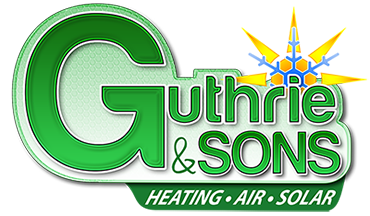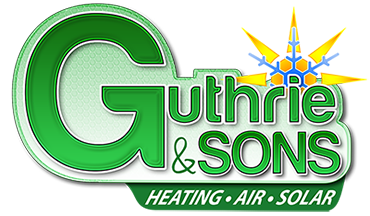If you’re trying to decide whether to repair or replace your air conditioning or heating system, you’re not alone—it’s one of the toughest calls homeowners face. You may have read something about the $5,000 rule for HVAC in your research on what to do next. Or, maybe you remember a contractor mentioning it years ago when your system was first installed.
But what does this rule really mean? When does it apply, and how much can you trust it? In this blog from Guthrie & Sons Heating, Air & Solar, we’ll explain where the $5,000 HVAC rule came from, how to use it, and when it might not tell the whole story. Get the facts straight from a trusted HVAC contractor in San Diego so you can make a smart, cost-effective decision about your HVAC system.

The $5,000 Rule for HVAC Explained
The $5,000 rule for HVAC is a quick formula homeowners can use to decide whether to repair or replace their heating or air conditioning system.
Here’s how it works:
- Take the age of your HVAC system in years.
- Multiply that number by the estimated repair cost.
- If the total is greater than $5,000, a system replacement is usually recommended.
- If it’s less than $5,000, a repair may be the smarter choice.
For example, let’s say your air conditioner is 10 years old and the repair estimate is $400. Multiply 10 x $400 = $4,000. Since that total is below $5,000, moving forward with the air conditioning repair probably makes sense.
But if that same system needed a $600 repair, the total would be $6,000—well above the threshold. In that case, an air conditioning replacement would likely be more cost-effective in the long run.
Now, consider your furnace or heat pump. If it’s 12 years old and you get a repair estimate of $350, you’d multiply 12 x $350 = $4,200. That’s still under $5,000, so a furnace repair or heat pump repair might be worthwhile for now. But if the repair was $500, the total becomes $6,000, suggesting that a replacement is likely the right move.
Why the $5,000 Rule Is Such a Helpful Guideline
The $5,000 rule for HVAC isn’t just a random number. It started as a simple way for technicians and homeowners to have a shared reference point when deciding between repair and replacement. Over time, contractors across the country began using it because it balanced three things that really matter: the age of the equipment, the repair cost, and the long-term value of the system.
The Average Lifespan of Systems
On average, air conditioning systems last about 10–15 years, and furnaces typically last 15–20 years. That lifespan can shrink or stretch depending on maintenance, usage, and the quality of the equipment. As your HVAC unit gets older, energy efficiency drops, and parts begin to wear out—leading to frequent breakdowns and higher repair costs.
The Relationship Between Repair Costs and Value
The rule helps you avoid spending thousands of dollars on a system that’s near the end of its useful life. For instance, putting $1,000 into a 15-year-old furnace with older technology rarely makes sense. The $5,000 formula shines a light on when repairs stop being cost-effective and when investing in a new system offers better long-term value.
Energy Efficiency and Utility Bills
Even if you keep fixing an older cooling system, it probably doesn’t perform as efficiently as it once did. Newer models use advanced components, smarter controls, and higher energy efficiency ratings. For an AC system, that means lower cooling costs, more consistent comfort, and energy savings that add up month after month. Over time, those savings can easily offset the upfront system replacement cost.
The best part of the $5,000 HVAC rule is that it puts clear numbers behind what can otherwise be an emotional or confusing choice. It helps you step back and see whether repairing your older unit will truly save money—or if it’s smarter to replace it and start fresh with reliable, efficient equipment. Either way, you’re making the decision based on facts, not guesswork.
When to Use the $5,000 Rule for HVAC
The $5,000 rule is most useful when you’re stuck between a repair estimate and the thought of a full replacement. Use it when:
- Your System Is Getting Older: If your air conditioner or furnace is more than 10 years old with frequent repairs and the bills are starting to add up, the formula can help determine if you’re better off upgrading.
- You’re Facing a Significant Repair: When the repair cost is several hundred dollars or more, the rule helps put that number into perspective—especially if it’s not your first repair this year.
- You’re Comparing Quotes or Planning Ahead: Maybe your system is still running but showing warning signs like uneven heating, loud noises, or rising energy bills. The rule gives you a benchmark to evaluate what makes the most sense in the long run.
When the $5,000 Rule for HVAC Doesn’t Apply
Like any rule of thumb, the $5,000 rule isn’t perfect. It’s a great starting point, but there are times when other factors matter more.
- When the Repair Is Simple or Minor: If the issue is just a loose wire, dirty coil, or bad thermostat, it might cost little to fix—even if the system is older. You don’t need to overthink those easy repairs.
- When Your System Is Newer or Still Under Warranty: A newer unit that’s less than 5–8 years old may still be covered under parts or labor warranty, reducing your out-of-pocket repair cost and changing the math.
- When You’re Planning to Move Soon: If you’ll be selling your home within a year or two, a quick, affordable repair might make more sense than a full replacement—especially if the system still runs efficiently.
What Else to Consider Along With the $5,000 HVAC Rule
Again, the $5,000 rule for HVAC is a great benchmark, but it’s not the only thing to think about when deciding between AC repair and AC replacement. Every home, budget, and system has unique factors that can affect what’s truly the more cost-effective option in the long run.
Wrong Size System
If your AC system was the wrong size from the start, it can lead to more frequent breakdowns, more wear on components, and lower energy efficiency overall. An undersized unit will run constantly trying to keep up, while an oversized system short-cycles and wastes energy. In either case, upgrading to a brand new unit properly matched to your home can improve comfort and reduce future repair costs.
Energy Rebates and Incentives
When weighing replacement options, don’t overlook energy rebates or tax incentives available through your utility company or state energy programs. These can make investing in a new HVAC system far more affordable and appealing than another AC repair. In many cases, the rebate savings alone make AC replacement the smarter, more cost-effective option.
Outdated Refrigerant
Many aging systems still use R-22 refrigerant, which is now discontinued and expensive to replace. If your older AC system springs a leak, the cost to recharge it can be steep—sometimes close to what you’d spend on a new system. In these cases, AC replacement is often the more cost-effective option, giving you peace of mind, better efficiency, and fewer frequent breakdowns in the future.
How Guthrie & Sons Uses the $5,000 Rule
At Guthrie & Sons Heating, Air & Solar, we see the $5,000 rule for HVAC as a conversation starter. It’s not meant to replace expert advice—but it does give you a smart, numbers-based starting point that helps take some of the uncertainty out of the decision.
When you call us for an HVAC repair, we’ll walk you through the numbers and what they mean for your home. You’ll get a clear explanation, an exact repair estimate, and honest guidance about whether it’s better for you to move forward with a repair or prepare for an HVAC replacement.
We’re not the kind of company that pushes for a sale just because it’s easier for us. We give you the facts, the math, and the reasoning, and we treat you the same way we’d want someone to treat our family: with honesty, respect, and a focus on what’s truly cost-effective for your situation. That’s the Guthrie way—it’s what’s right, and it’s what you deserve.
Make an Appointment With Our Trusted Team Today
Is your furnace struggling to keep up? Is your AC blowing warm air or costing more to run each month? Is your heat pump making strange noises or cycling on and off too often?
Whatever’s going on, Guthrie & Sons Heating, Air & Solar will get to the bottom of it and get you on the right path to a solution. Call our office or send us a message today to get a technician out to you anywhere in San Diego County, Temecula, and Murrieta.





















